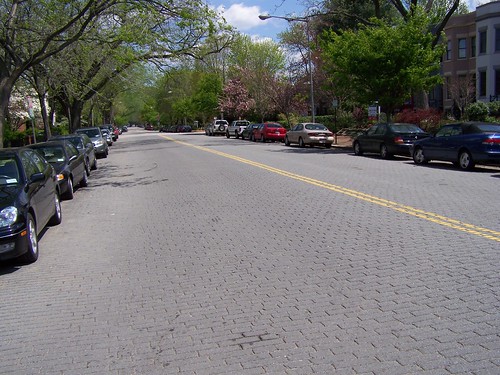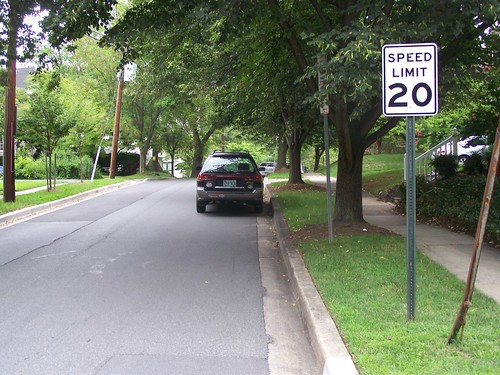Pedestrian safety and the proposed 15mph residential speed limit in DC: Part One
From Councilmember Bowser's Constitutent Newsletter:
This week, I introduced the Pedestrian Safe Streets Speed Limit Amendment Act. The bill would set the speed limit at 15 mph on residential streets. The Federal Highway Administration says that in 1969 about half of all school students walked or bicycled to school. Today that number has shrunk to fewer than 15 percent. Many parents cite traffic safety issues as a major concern for not allowing their children to bicycle or walk to school. The World Health Organization has shown that the probability of serious injury during a crash is at least three times as great at 30 mph and four times as great at 40 mph compared to the risk below 20 mph. And, pedestrians have at least a 90% chance of surviving a car crash at 15 mph. This legislation is not intended to affect our main commuter arteries and thoroughfares such as Georgia Avenue or Connecticut Avenue. What it's intended to do is to make our residential streets safer for our residents and again provide certainty and predictability for drivers. My goal is to make our neighborhoods safe again and to make walking and bicycling to school a safe and routine activity once again as well.
As a transportation planner, while I think the legislation for 15mph is well intended, it bothers me terribly that every year Council puts forward a variety of (unresearched) transportation related initiatives, but the city lacks a master transportation plan (say comparable to Arlington's, which is one of the best in the country), where these kinds of policies should be addressed, and the DDOT, Office of Planning, and Council isn't taking the initiative to get such a plan produced.
In response to the speed issue generally, one of the "problems" we have in the city with the 25mph standing speed limit is that it is inadequately "marketed" at the city's entry points, so that people who drive in places where 25mph is not the prevailing speed limit--basically everywhere other than DC--are caught unaware, and drive fast, because regardless of the posted speed limit, roads are engineered and constructed for the most part to allow for high speeds.
- see pgs. 42-44 from the (Pennsylvania) Smart Transportation Guidebook about "design speed" vs. "desired speed" on roadways
There are many programs in Europe focused on speed reduction, which started in Graz, Austria in the early 1990s. There, they focus on 30kph/50kph programs of 30kph (about 18mph) for residential streets, and 50kph (32mph) for arterials. England has a comparable program of "Twenty's Plenty". Montreal recently introduced a similar program of 30kph and 40kph speeds in residential areas and 50kph on arterials. And closer to home, I've noticed in the Town of Chevy Chase that some of the residential roads are posted at 20mph. Note that in the 1940s, the speed limit for many residential streets in DC was 15mph, according to historic photos from the Wymer Collection at the Historical Society.
Stanford Street at East Avenue, Town of Chevy Chase
-- "London 20mph zones," from Streetsblog,
Note that the Dutch members of their national bike association, here last year for a workshop on applying Dutch thinking to DC's bike infrastructure, thought that speed limits were an issue to raise, especially in the core of the city.
Anyway, while many residents complain of massive speeding on various residential streets in the city, for the most part in my experience that isn't true, because of the relatively narrow roads, and the presence of parking on the streets, which also reduces speed. Although there is no question that on some streets, usually arterials and collectors, because of the width of the road, the quality of the pavement, etc., conditions for speeding are ripe.
Although, that's why for years I have suggested "re-engineering" local streets around parks, schools, libraries, and commercial districts to Belgian block (or like the pavers on 7th Street SE in front of Eastern Market), which provide visual, aural, and physical clues to drive more slowly. Frankly, I'd rather have roads made of Belgian Block, instead of adding speed bumps and the like. By judiciously using different pavements, we can "naturally" reduce speeds rather than by building all roads as if they should be driven at 50mph.
Eastern Market, DC.

Interestingly, the 25mph prevailing speed limit that DC has is one of the "lowest" in the U.S. (that's why I was surprised to see the 20mph sign in Chevy Chase). Even in NYC, their prevailing speed on residential streets is 30mph. And in most suburbs, even on residential streets, the speed limit is usually 35mph. Probably, for the most part, residents know and follow the 25mph limit. The issue is with non-residents (although not completely).
In planning, we don't like to recommend initiatives that are likely to be massively ignored, or create significant burdens for enforcement.
I can see creating 20mph zones (not unlike the 15mph zones during school hours near schools) on residential streets, while keeping most arterials in mixed residential-commercial zones (such as Georgia Avenue or H Street NE) at 25mph.
Labels: car culture and automobility, traffic engineering, transportation planning, urban design/placemaking, walking






0 Comments:
Post a Comment
<< Home